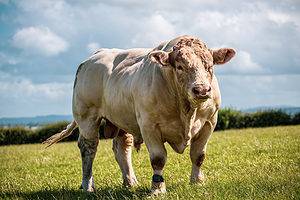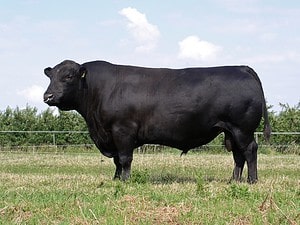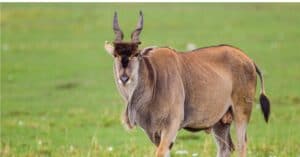Hoards of fluffy Highland cows — or “coos” — are taking over the internet, and for good reason! With their long horns, impressively long and shaggy hair, gentle nature, and expressive personalities, these beautiful bovines look like they stepped straight out of a fairy tale. Let’s look closer at these iconic “fluffy cows,” their origins, and their rich cultural history!
What Are “Fluffy Cows”?

Highland cattle are easy to recognize due to their long, shaggy coats.
©attilio pregnolato/Shutterstock.com
The iconic “fluffy cows” taking over the internet are Scottish Highland cows. Also known as “Heilan coos” and “hairy coos,” this fascinating breed of cattle originates in the Scottish Highlands and the Western Isles of Scotland. Female heifers weigh up to 1,100 pounds, while bulls weigh up to 1,800 pounds. Both male and female cows have impressive horns, but males are typically thicker and less curvy.
Highland cows stand out from other breeds due to their glorious thick double coats’ recognizably “fluffy” appearance. This dense hair can vary in color, ranging from red to brown, black, brindle, pale silver, and even yellow. However, the reddish-brown coats are the most common, which comprise about 60% of the population.
Where Do Fluffy Cows Come From?

Highland cows are adapted to live and thrive in the harsh conditions of the Scottish Highlands.
©Benjamin Frankum/iStock via Getty Images
Highland cows are the oldest cattle breed in the world. Their rich history traces back to Scotland, where they have thrived in the harsh and isolated Highlands for centuries. The breed’s lineage can be found in the first herd book from the Highland Cattle Society in 1885. However, their roots go back even further — such as written records from the twelfth century and archeological evidence from as far back as the sixth century.
Highland cattle became especially important to the Scottish economy during the eighteenth century, with thousands sold to England. Highland cattle later debuted in the United States in the late 1890s. U.S. cattlemen imported Highland cattle to help increase the resilience of their herds.
Still popular in Scotland today, you can also find fluffy Highland cows in North America, Australia, and Europe. It is said that the British royal family only eats highland beef from the High cattle they keep at Balmoral Castle. Queen Elizabeth II started her fold of Highland cattle in 1953, and today, their descendants roam around the castle’s expansive 50,000 acres. Some of the queen’s cows can trace their lineage back to the reign of Queen Victoria!
Types of Highland Cow Breeds

Most Highland cows are reddish-brown but come in other colors like black and cream.
©OE993/iStock via Getty Images
During the early days, there were two main types of Highland cows. The first, known as Kyloe, lived mainly on the islands along the western coast of northern Scotland. These cows were slightly smaller and usually black. The second type roamed the remote Highlands of Scotland and was larger than Kyloe, with a reddish hue to their coats. The two types are now recognized as one single breed, the Highland cow.
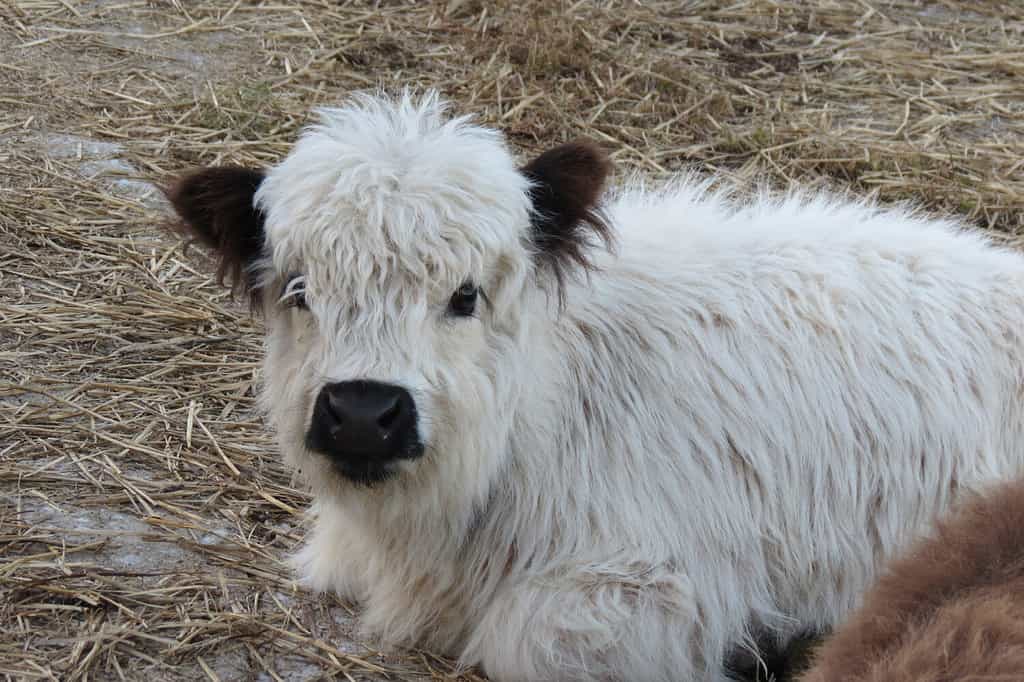
Miniature Highland cows are popular due to their smaller size and calm temperament.
©stevetucker/Shutterstock.com
In addition, today, you can also find miniature Highland cows. These cute cows look much like their larger counterparts, but they only grow about 42 inches tall and weigh 500 to 1,000 pounds as adults. In comparison, a regular-sized male Highland cow can weigh up to 1,800 pounds, while a female cow can weigh up to 1,000 pounds.
Miniature Highland cows are becoming increasingly popular as animal companions and foragers on farms due to their hardy nature and sweet temperament. However, they require a lot of space and do not make good pets for suburban homes. In addition, these smaller-sized cows are still very social herd animals, so they must live in groups with other miniature cows or similar-sized species. If left alone, miniature Highland cows become overly stressed, and their health suffers.
Highland Cows as a Symbol of Scotland
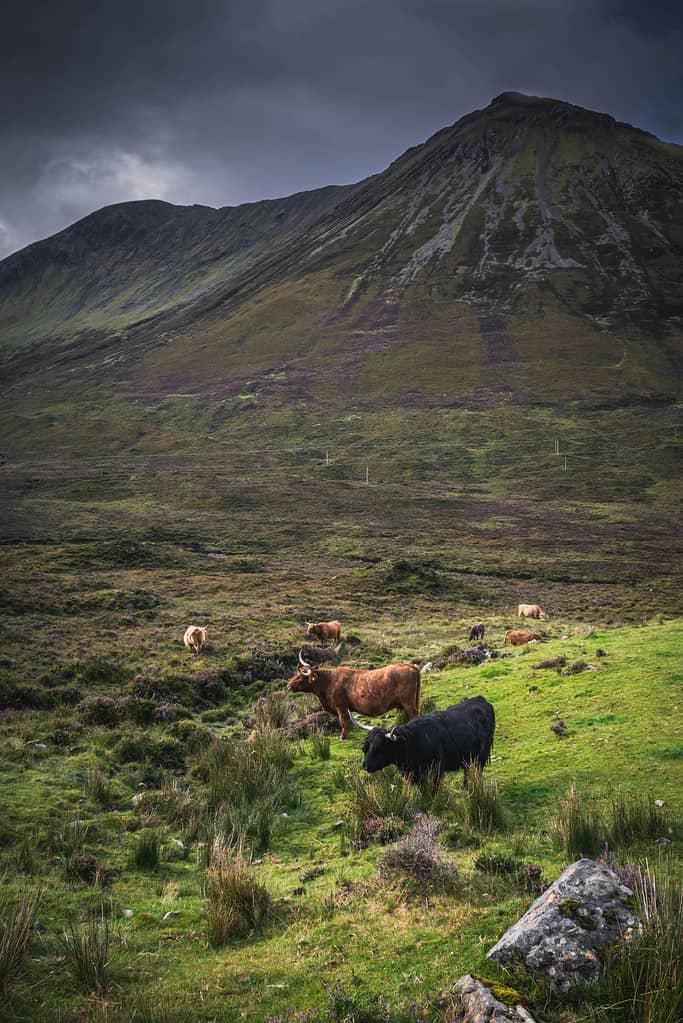
Highland cows have roamed the Scottish Highlands for over 1,000 years!
©Anastasija Mosina/iStock via Getty Images
Inseparable from Scotland, Highland cattle are iconic symbols of the country’s rugged landscapes and indomitable spirit. They are a resilient and rugged breed ideally suited to endure their Highland homeland’s cold, wet weather and challenging terrain. In other words, Highland cattle are not just well-adapted to the Scottish climate — they thrive in it! These incredible cows endure harsh weather conditions with unwavering resilience, capturing the unyielding spirit that courses through the veins of the Scottish people.
In addition, Highland cows are free-ranging animals that are generally self-sufficient, symbolizing the strength and independence of Scottish culture. As an iconic part of the country’s stunning landscape, they also connect the people to the natural world and rugged terrain of the Scottish Highlands.
Today, these beautiful fluffy cows are synonymous with Scottish culture, capturing the hearts of locals and visitors alike. People travel worldwide to see Highland cattle in Scotland and bring home all kinds of bovine-themed gifts and Scottish souvenirs.
The Incredible Resilience and Adaptability of Highland Cows

Scottish Highland cattle are one of the hardiest breeds in the world.
©Viesinsh/iStock via Getty Images
While most European cattle are well equipped to brave the cold, Highland cattle are a whole different breed. These incredible fluffy cows have been hailed as the champions of chilly weather — they’re almost as tough as the caribou and reindeer who call the Arctic their home! They even have a longer lifespan than other cattle, often living to be 20 years old.
Generally, a group of cattle is called a “herd,” but Highland cattle gather together in “folds.” This name comes from the open stone shelters where the cows were kept in the Scottish highlands during bitter winters.
The weather conditions of the Scottish Highlands can be very challenging. One moment, it could be sunny and warm, and then suddenly, the land is drenched in a downpour, snow, or bone-chilling winds. Traditionally, Highland cattle were brought into open stone shelters called “folds” to help protect them from the bitter cold — which is also why groups of Highland cattle are referred to as “folds” rather than “herds.”
Due to natural selection over many centuries, Highland cows have adapted to the challenging environment of the Scottish Highlands. Folds of Highland cows have even been successfully raised in countries with colder winters than Scotland, like Canada and Norway.
Unique Adaptations of the Highland Cow

Highland cows have unique stomachs that allow them to digest lower-quality vegetation.
©alfee0/Shutterstock.com
These incredibly tough and well-adapted cows live and thrive in the harsh weather conditions of their Highland home. In contrast to other cattle breeds, Highland cattle can graze on lower-quality pastures. They often prefer foraging rather than feeding in a barn and browse amongst trees, shrubs, and weeds. Highland cows use their large horns to rake up the snow and dig for roots and buried vegetation when food is scarce.
In addition, their long, shaggy hair creates a wooly double coat. The coarse and oily outer layer protects them against the elements, and the soft, downy inner layer keeps them warm and cozy. This unique combination provides insulation and protection against the elements, allowing the cows to thrive in the cold and wet climate of the Scottish Highlands.
Highland Cow Temperament and Behavior

Each Highland cow has its own unique personality.
©Parasoliastock/iStock via Getty Images
Thanks to their exceptional intelligence and deep understanding of their social hierarchy, Highland cows are gentle and submissive. Older cattle reign over the fold, with the males dominating their female counterparts. In addition, the offspring of the top-ranking cows of the group automatically inherit a higher social status, like being born into a special bovine royal line. Highland cows are very social animals who rarely show aggression. They also have unique personalities and like to have fun, often licking each other and play-fighting.
The incredibly gentle nature of Highland cows can make them easy to care for, and when socialized from a young age, many even enjoy being around humans. Some seek affection from the humans they know and trust, often walking alongside them. However, you should always exercise caution, as those enormous horns can do much damage!
Highland Cows: Beef, Milk, and Sustainability
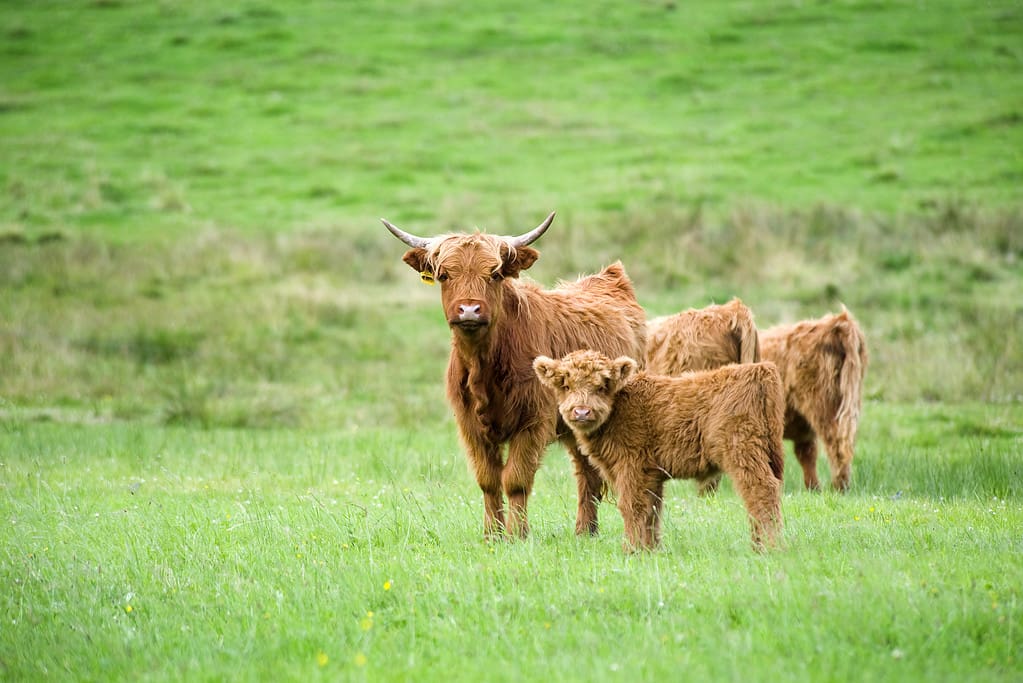
Both male and female Highland cows grow horns as they get older.
©Guenter Guni/iStock via Getty Images
Many farmers raise Highland cows for their lean and flavorful meat. The composition of Highland beef is quite different from other cattle breeds due to their unique adaptations in the harsh environment of the Scottish Highlands. Their thick double coats provide excellent insulation, which means the cows don’t need to produce as much fat on their bodies to keep them warm. This produces lean and well-marbled premium beef with a succulent flavor and delicate texture. Highland beef is also high in protein, iron, and much less fat and cholesterol.
In addition, Highland cow farming offers a more environmentally friendly approach than other cattle breeds. Highland cows have a gentler impact on their environment, which makes them a more sustainable choice. Their hardy nature, healthy constitution, and gentle temperament make these cows easier to care for and less expensive than other cattle breeds.
Highland cows are also raised for their milk, although due to their smaller teats, they don’t produce nearly as much as specialized milk cows. On average, a single highland cow produces about 2 gallons of milk daily, but that’s plenty for personal use. Highland cow milk also has an impressively high butterfat content of up to 10%. Of course, while some farmers find the rich buttery milk delicious and appealing, others say it is an acquired taste.
Many farmers prefer Highland cattle for agritourism. Tourists from all over the world flock to Scotland to experience the beauty of the countryside and get up close and personal with these fluffy cows. Others also keep Highland cattle for landscape management. These mighty beasts have a knack for grazing in specific areas and helping maintain the balance of the ecosystem.
Are There Other Types of “Fluffy” Cows?
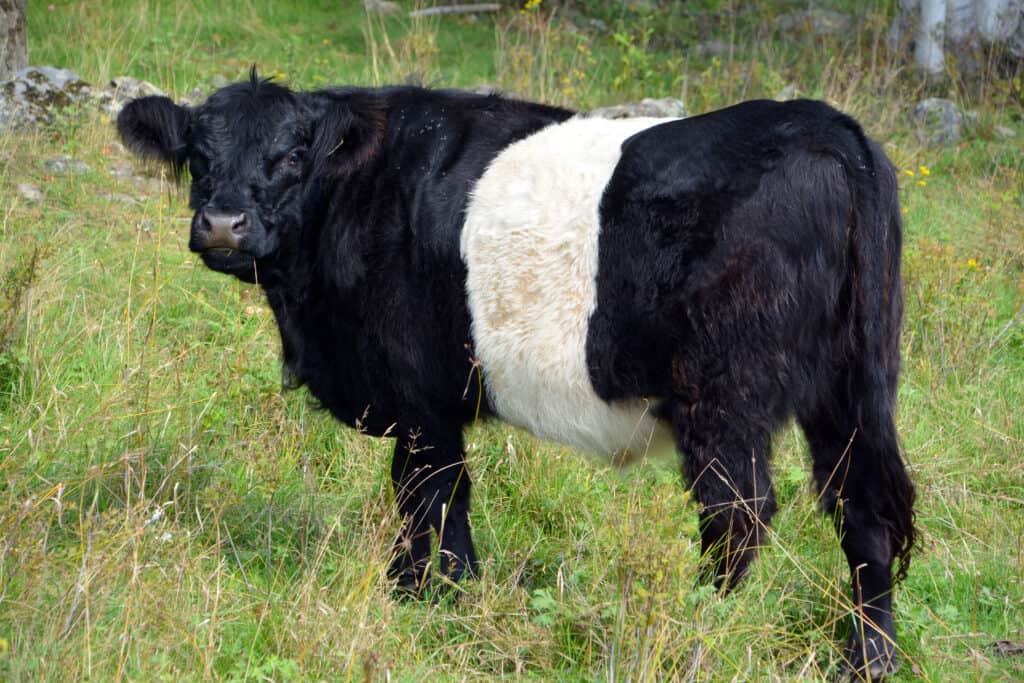
Belted galloways are easily distinguished by their “belt” of white hair.
©meunierd/Shutterstock.com
The luxurious long coat of the Highland cow is hard to beat, rivaling just about any spectacular hairstyle you can find. However, a few other cow breeds have a fluffy appearance. Galloway cows, for example, are another furry cattle breed native to Scotland. Originating in the seventeenth or eighteenth century, Galloway cows have thick and wavy double-layered coats with coarse and wavy hair. They are usually black, but can also be red or dun. Belted Galloway cows, on the other hand, sport a striking white marking marking encircling their bodies, which looks like a wide belt. There are also miniature belted Galloway cows as well.
Yaks also have some pretty impressive hair. Hanging lower than their bellies, yak hair is dense and long, typically sporting dark colors. However, domestic yaks may also have cream or rusty brown hues. Also known as “hairy cattle,” yaks have large horns and bulky bodies.
The photo featured at the top of this post is © Benjamin Frankum/iStock via Getty Images
Thank you for reading! Have some feedback for us? Contact the AZ Animals editorial team.



